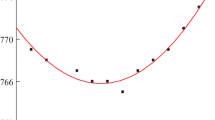Summary
In contrast to the general belief that coiling always makes a GC-column worse, in this article is shown that, based on secondary flow phenomena, this rule of thumb is not true in general. With the aid of the work of Adler a theory is developed from which it can be concluded that coiling of columns can have either a positive or a negative effect on column-performance, depending on a criterion in which the mobile phase velocity and the aspect ratio (columndiameter/helixdiameter) play an important role. Equations have been derived which establish the relation HETP vs ū for open helical columns. It is shown that open helical columns have a H vs ū plot that is curved towards the velocity axis for the higher velocities. Application of helical columns therefore can be useful in high-speed analysis as a good column-efficiency is maintained. The performed experiments do support the theory given here and will be published in a second part of this series.
Zusammenfassung
Im Gegensatz zu der allgemeinen Auffassung, daß es der Trennleistung immer abträglich ist, eine gas-chromatographische Kolonne zu wickeln, wird in dieser Arbeit dargelegt, beruhend auf einer auftretenden Sekundärströmung, daß diese Regel nicht allgemein gültig ist. Mit Hilfe eines Aufsatzes von Adler wird eine Theorie vorgeschlagen, woraus hervorgeht, daß das Wickeln von Kolonnen, abhängig von der mobilen Phasengeschwindigkeit und dem Verhältnis Kolonnendurchmesser/Spiralendurchmesser, entweder einen günstigen oder einen schädlichen Einfluß auf die Trennleistung hat. Es werden Gleichungen für die Beziehung HETP gegen ū für Spiralkolonnen abgeleitet. Gezeigt wird, daß diese Kolonnen eine Beziehung H gegen ū besitzen welche in graphischer Darstellung für hohe Geschwindigkeiten der Geschwindigkeitsachse zuneigt. Eine Anwendung von Spiralkolonnen kann deswegen bei Schnellanalysen nützlich sein, da eine gute Trennleistung beibehalten bleibt. Die bisherigen Versuche unterstützen die Theorie und werden als zweiter Teil dieser Serie erscheinen.
Sommaire
En contradiction avec la règle générale, selon laquelle l'enroulement de la colonne de chromatographie en phase gazeuse diminue son efficacité cet article qui tient compte du phénomène de courant secondaire montre que cette règle n'est pas toujours verifiée. En tenant compte des observations d'Adler, une théorie peut être développé qui nous permet de conclure que le bobinage de la colonne a une influence favorable aussi bien que défavorable sur l'efficacité, qui dépend de la vitesse lineaire du gaz vecteur et du rapport diamètre de la colonne/diamètre de la bobine. Des équations sont déduites; elles montrent la relation entre H et ū pour des colonnes à film liquide spiralées La courbe qui représente l'HETP en fonction de ū est plus écartée vers l'axe de la vitesse pour les grandes valeurs de cette vitesse. Alors des applications de la colonne spiralée peuvent être utiles pour la chromatographie ultra-rapide car une bonne efficacité est maintenue. Jusqu'ici les expériences faites confirment la théorie, elles seront publiées dans un deuxième article.
Similar content being viewed by others
References
G. W. A. Rijnders, “Advances in Chromatography” (Giddings-Keller eds.) New York 1966, Vol. III, p. 215.
A. B. Littlewood, Anal. Chem.38, (1966) 1.
e. g.J. C. Giddings: “Dynamics of Chromatography” part I, New York 1965.
S. T. Sie, G. W. A. Rijnders, Anal. Chim. Acta38 (1966) 1.
R. S. Deelder, J. Chromatog.47 (1970) 307.
G. J. Taylor, Proc. Roy. Soc. (London)A219 (1953) 186;A225 (1954) 473.
R. Aris, Proc. Roy. Soc. (London)A235 (1956) 67.
M. J. E. Golay, “Gas Chromatography 1958” (Desty ed.) London 1958, 36.
G. J. Taylor, Proc. Roy. Soc. (London)A223 (1954) 446.
e.g.J. D. Schieke, T. W. Smuts, V. Pretorius, Separation Sci.3 (1968) 27.
J. H. Knox, Anal. Chem.38 (1966) 253.
J. C. Giddings, W. A. Manwaring, M. N. Myers, Scince154 (1966) 146.
J. A. Koutsky, R. J. Adler, Can. J. Chem. Eng.43 (1964) 239.
C. G. Horvath, B. A. Preiss, S. R. Lipsky, Anal. Chem.39 (1967) 1422.
M. Adler, Z. Angew. Math. Mech.14 (1934) 257.
E. Becker, Mitteilungen Max Planck Institut für Strömungs-forschung mr. 13, Göttingen 1956.
seeS. Goldstein, “Modern Developments in Fluid Dynamics” New York 1965, Vol. I, 321.
J. Eustice, Engineering120 (1925) 604.
G. J. Taylor, Proc. Roy. Soc. (London)A124 (1929) 243.
O. Levenspiel, K. B. Bischoff, Adv. Chem. Eng.4, (1963) 95.
W. R. Dean, Phil. Mag.4 (1927) 208;5 (1928) 682.
H. G. Cuming, Aeronautical Research Council Reports and Memoranda no. 2880, London 1955.
J. C. Giddings, J. Chromatog.3 (1960) 520.
J. M. Matsen, J. W. Harding, J. Chromatog.12(1963) 145.
e.g.H. S. Carslaw, J. C. Jaeger, “Conduction of Heat in Solids” Oxford 1959.
A. B. Littlewood, ”Gas Chromatography 1964” (Goldup ed.) London 1965. 77.
R. P. W. Scott;D. W. J. Blackburn, T. Wilkins, J. Gas Chromatography5 (1967) 183.
T. Wilkins, communication during discussions Symposium on Physical Separation Methods in Chemical Analysis, Amsterdam 1967.
G. W. Johnson, Thesis, Rensselaer Polytechnic Inst. Troy, New York 1967.
to be published in this journal.
Author information
Authors and Affiliations
Rights and permissions
About this article
Cite this article
Tijssen, R. Effect of column-coiling on the dispersion of solutes in gas chromatography. Chromatographia 3, 525–531 (1970). https://doi.org/10.1007/BF02268495
Received:
Accepted:
Issue Date:
DOI: https://doi.org/10.1007/BF02268495




